BUS708 Case Study: A Comprehensive Analysis of the TTIP Agreement
VerifiedAdded on 2023/04/21
|14
|3682
|53
Case Study
AI Summary
This case study provides a comprehensive analysis of the Transatlantic Trade and Investment Partnership (TTIP), proposed by President Barack Obama. It evaluates the benefits of the agreement, such as eliminating excessive tariffs and boosting economic growth for both American and EU companies, while also considering drawbacks like potential hindrances to the automobile and medicine industries. The study contrasts the level of opposition to TTIP with that of the North American Free Trade Agreement (NAFTA), explaining the differing political resistance based on the perceived benefits and impacts on the American economy. Furthermore, it examines the political resistance faced by the Trans-Pacific Partnership (TPP) compared to TTIP, highlighting concerns about competition from developing nations. The analysis concludes by considering the potential benefits and drawbacks of President Trump's decision to withdraw from TTIP negotiations, offering a balanced perspective on the agreement's overall implications.
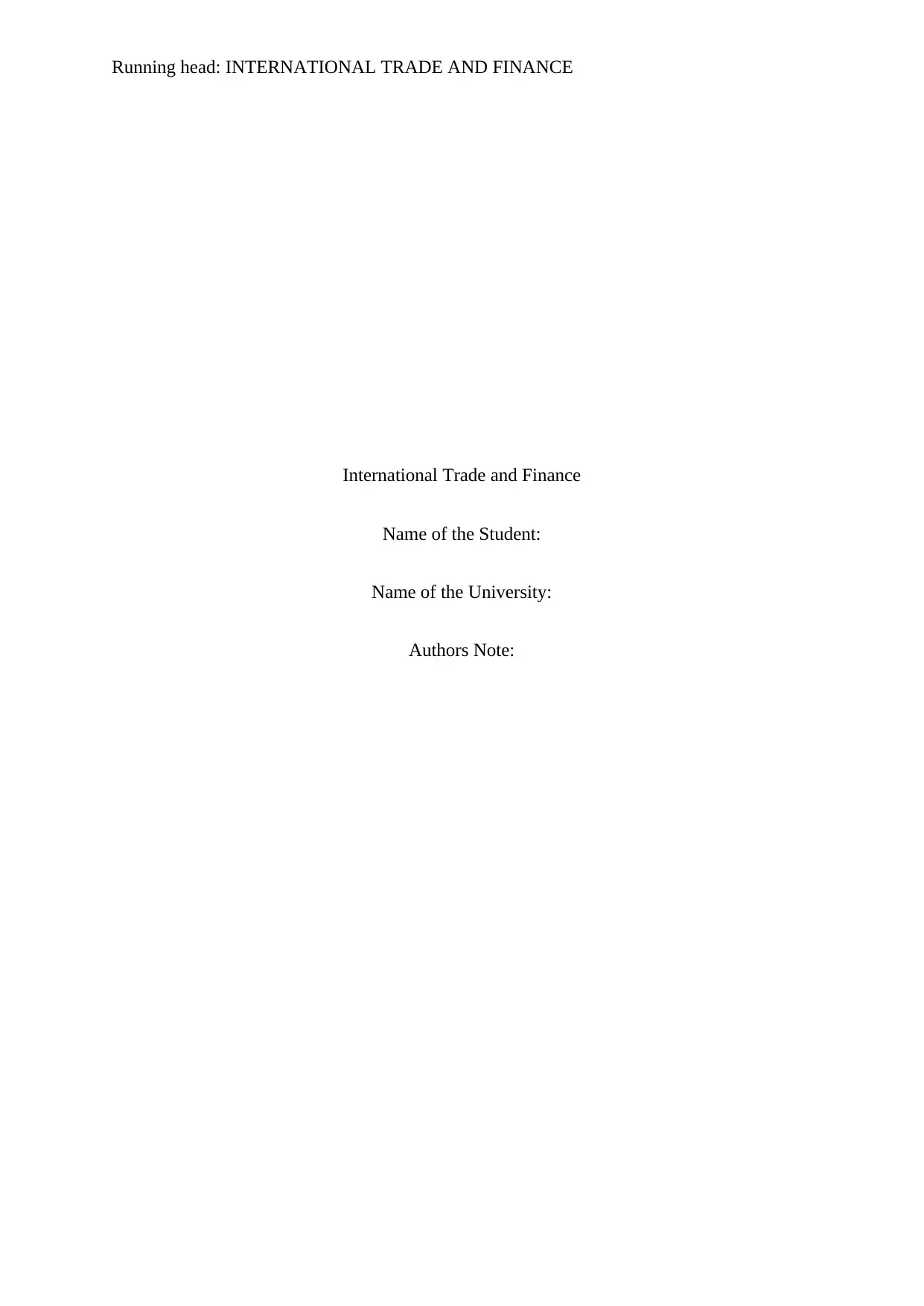
Running head: INTERNATIONAL TRADE AND FINANCE
International Trade and Finance
Name of the Student:
Name of the University:
Authors Note:
International Trade and Finance
Name of the Student:
Name of the University:
Authors Note:
Paraphrase This Document
Need a fresh take? Get an instant paraphrase of this document with our AI Paraphraser
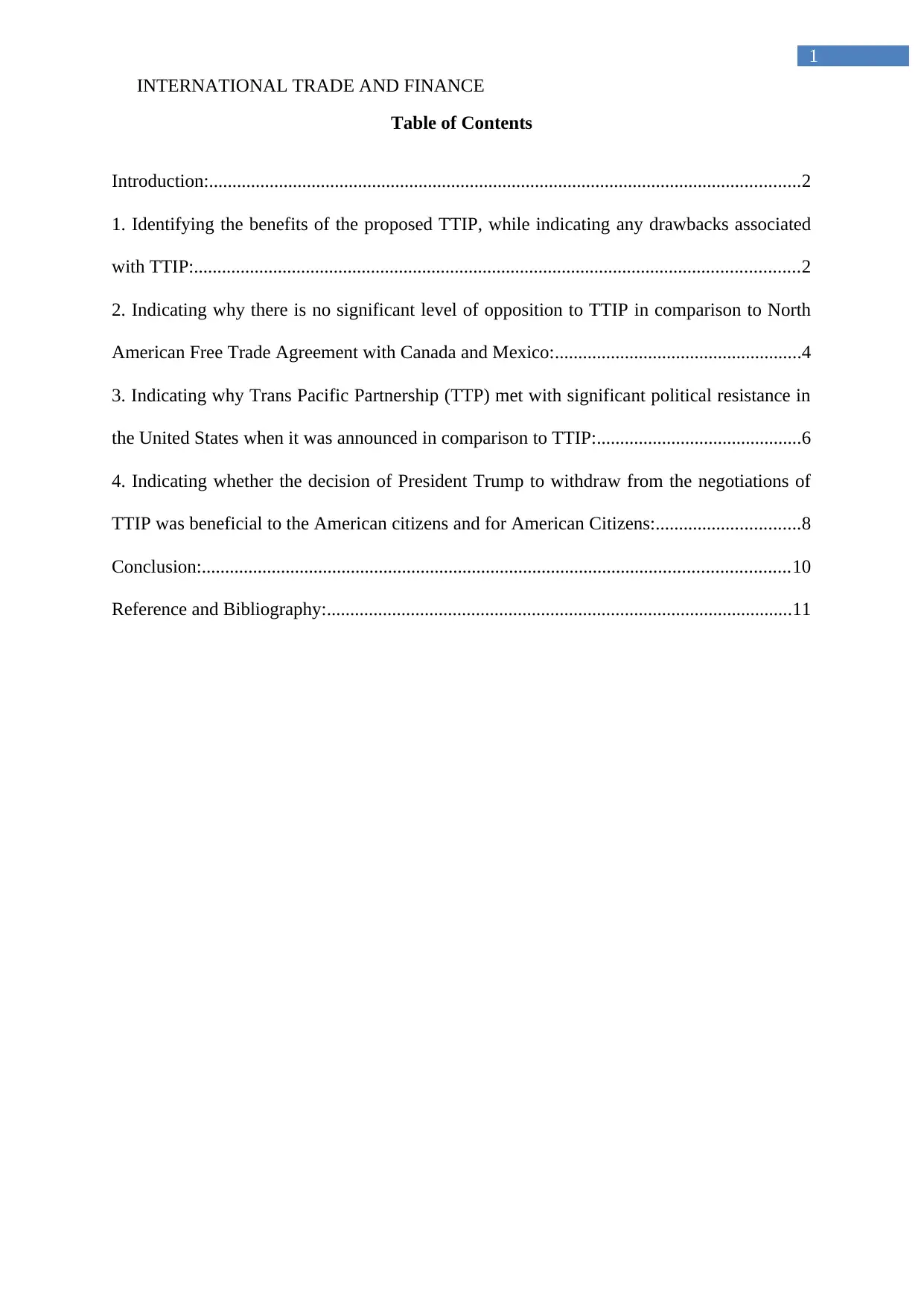
INTERNATIONAL TRADE AND FINANCE
1
Table of Contents
Introduction:...............................................................................................................................2
1. Identifying the benefits of the proposed TTIP, while indicating any drawbacks associated
with TTIP:..................................................................................................................................2
2. Indicating why there is no significant level of opposition to TTIP in comparison to North
American Free Trade Agreement with Canada and Mexico:.....................................................4
3. Indicating why Trans Pacific Partnership (TTP) met with significant political resistance in
the United States when it was announced in comparison to TTIP:............................................6
4. Indicating whether the decision of President Trump to withdraw from the negotiations of
TTIP was beneficial to the American citizens and for American Citizens:...............................8
Conclusion:..............................................................................................................................10
Reference and Bibliography:....................................................................................................11
1
Table of Contents
Introduction:...............................................................................................................................2
1. Identifying the benefits of the proposed TTIP, while indicating any drawbacks associated
with TTIP:..................................................................................................................................2
2. Indicating why there is no significant level of opposition to TTIP in comparison to North
American Free Trade Agreement with Canada and Mexico:.....................................................4
3. Indicating why Trans Pacific Partnership (TTP) met with significant political resistance in
the United States when it was announced in comparison to TTIP:............................................6
4. Indicating whether the decision of President Trump to withdraw from the negotiations of
TTIP was beneficial to the American citizens and for American Citizens:...............................8
Conclusion:..............................................................................................................................10
Reference and Bibliography:....................................................................................................11
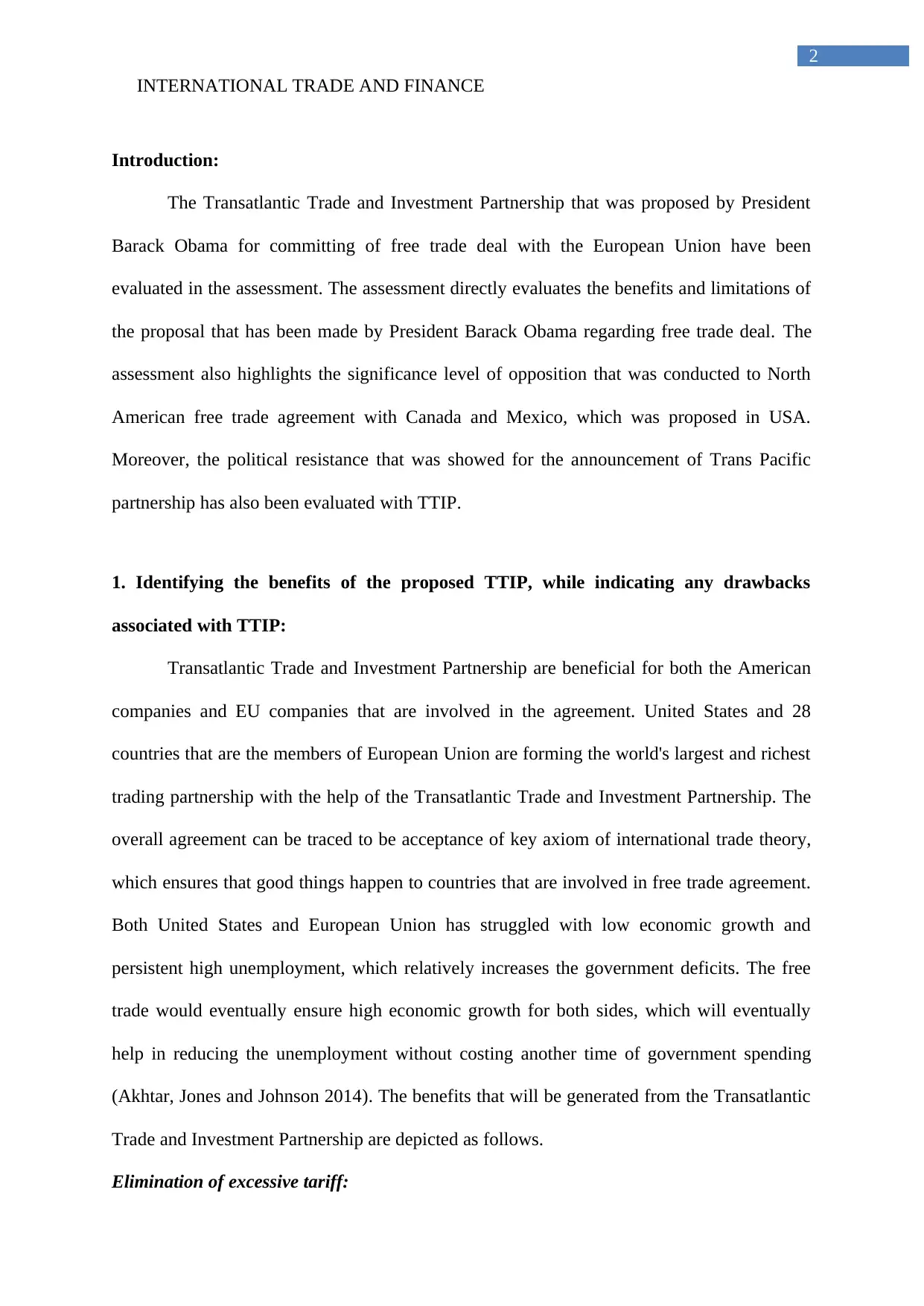
INTERNATIONAL TRADE AND FINANCE
2
Introduction:
The Transatlantic Trade and Investment Partnership that was proposed by President
Barack Obama for committing of free trade deal with the European Union have been
evaluated in the assessment. The assessment directly evaluates the benefits and limitations of
the proposal that has been made by President Barack Obama regarding free trade deal. The
assessment also highlights the significance level of opposition that was conducted to North
American free trade agreement with Canada and Mexico, which was proposed in USA.
Moreover, the political resistance that was showed for the announcement of Trans Pacific
partnership has also been evaluated with TTIP.
1. Identifying the benefits of the proposed TTIP, while indicating any drawbacks
associated with TTIP:
Transatlantic Trade and Investment Partnership are beneficial for both the American
companies and EU companies that are involved in the agreement. United States and 28
countries that are the members of European Union are forming the world's largest and richest
trading partnership with the help of the Transatlantic Trade and Investment Partnership. The
overall agreement can be traced to be acceptance of key axiom of international trade theory,
which ensures that good things happen to countries that are involved in free trade agreement.
Both United States and European Union has struggled with low economic growth and
persistent high unemployment, which relatively increases the government deficits. The free
trade would eventually ensure high economic growth for both sides, which will eventually
help in reducing the unemployment without costing another time of government spending
(Akhtar, Jones and Johnson 2014). The benefits that will be generated from the Transatlantic
Trade and Investment Partnership are depicted as follows.
Elimination of excessive tariff:
2
Introduction:
The Transatlantic Trade and Investment Partnership that was proposed by President
Barack Obama for committing of free trade deal with the European Union have been
evaluated in the assessment. The assessment directly evaluates the benefits and limitations of
the proposal that has been made by President Barack Obama regarding free trade deal. The
assessment also highlights the significance level of opposition that was conducted to North
American free trade agreement with Canada and Mexico, which was proposed in USA.
Moreover, the political resistance that was showed for the announcement of Trans Pacific
partnership has also been evaluated with TTIP.
1. Identifying the benefits of the proposed TTIP, while indicating any drawbacks
associated with TTIP:
Transatlantic Trade and Investment Partnership are beneficial for both the American
companies and EU companies that are involved in the agreement. United States and 28
countries that are the members of European Union are forming the world's largest and richest
trading partnership with the help of the Transatlantic Trade and Investment Partnership. The
overall agreement can be traced to be acceptance of key axiom of international trade theory,
which ensures that good things happen to countries that are involved in free trade agreement.
Both United States and European Union has struggled with low economic growth and
persistent high unemployment, which relatively increases the government deficits. The free
trade would eventually ensure high economic growth for both sides, which will eventually
help in reducing the unemployment without costing another time of government spending
(Akhtar, Jones and Johnson 2014). The benefits that will be generated from the Transatlantic
Trade and Investment Partnership are depicted as follows.
Elimination of excessive tariff:
⊘ This is a preview!⊘
Do you want full access?
Subscribe today to unlock all pages.

Trusted by 1+ million students worldwide
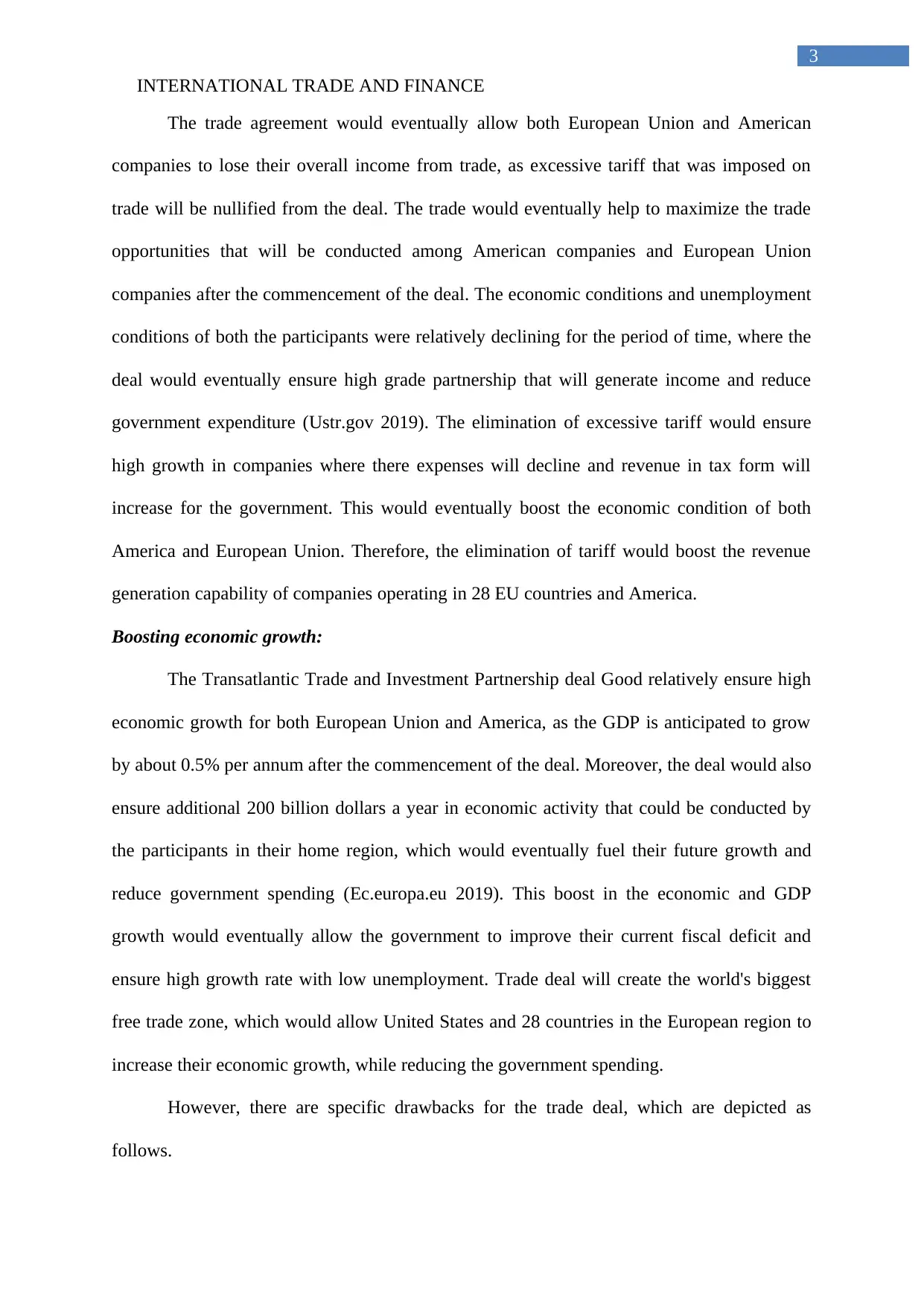
INTERNATIONAL TRADE AND FINANCE
3
The trade agreement would eventually allow both European Union and American
companies to lose their overall income from trade, as excessive tariff that was imposed on
trade will be nullified from the deal. The trade would eventually help to maximize the trade
opportunities that will be conducted among American companies and European Union
companies after the commencement of the deal. The economic conditions and unemployment
conditions of both the participants were relatively declining for the period of time, where the
deal would eventually ensure high grade partnership that will generate income and reduce
government expenditure (Ustr.gov 2019). The elimination of excessive tariff would ensure
high growth in companies where there expenses will decline and revenue in tax form will
increase for the government. This would eventually boost the economic condition of both
America and European Union. Therefore, the elimination of tariff would boost the revenue
generation capability of companies operating in 28 EU countries and America.
Boosting economic growth:
The Transatlantic Trade and Investment Partnership deal Good relatively ensure high
economic growth for both European Union and America, as the GDP is anticipated to grow
by about 0.5% per annum after the commencement of the deal. Moreover, the deal would also
ensure additional 200 billion dollars a year in economic activity that could be conducted by
the participants in their home region, which would eventually fuel their future growth and
reduce government spending (Ec.europa.eu 2019). This boost in the economic and GDP
growth would eventually allow the government to improve their current fiscal deficit and
ensure high growth rate with low unemployment. Trade deal will create the world's biggest
free trade zone, which would allow United States and 28 countries in the European region to
increase their economic growth, while reducing the government spending.
However, there are specific drawbacks for the trade deal, which are depicted as
follows.
3
The trade agreement would eventually allow both European Union and American
companies to lose their overall income from trade, as excessive tariff that was imposed on
trade will be nullified from the deal. The trade would eventually help to maximize the trade
opportunities that will be conducted among American companies and European Union
companies after the commencement of the deal. The economic conditions and unemployment
conditions of both the participants were relatively declining for the period of time, where the
deal would eventually ensure high grade partnership that will generate income and reduce
government expenditure (Ustr.gov 2019). The elimination of excessive tariff would ensure
high growth in companies where there expenses will decline and revenue in tax form will
increase for the government. This would eventually boost the economic condition of both
America and European Union. Therefore, the elimination of tariff would boost the revenue
generation capability of companies operating in 28 EU countries and America.
Boosting economic growth:
The Transatlantic Trade and Investment Partnership deal Good relatively ensure high
economic growth for both European Union and America, as the GDP is anticipated to grow
by about 0.5% per annum after the commencement of the deal. Moreover, the deal would also
ensure additional 200 billion dollars a year in economic activity that could be conducted by
the participants in their home region, which would eventually fuel their future growth and
reduce government spending (Ec.europa.eu 2019). This boost in the economic and GDP
growth would eventually allow the government to improve their current fiscal deficit and
ensure high growth rate with low unemployment. Trade deal will create the world's biggest
free trade zone, which would allow United States and 28 countries in the European region to
increase their economic growth, while reducing the government spending.
However, there are specific drawbacks for the trade deal, which are depicted as
follows.
Paraphrase This Document
Need a fresh take? Get an instant paraphrase of this document with our AI Paraphraser
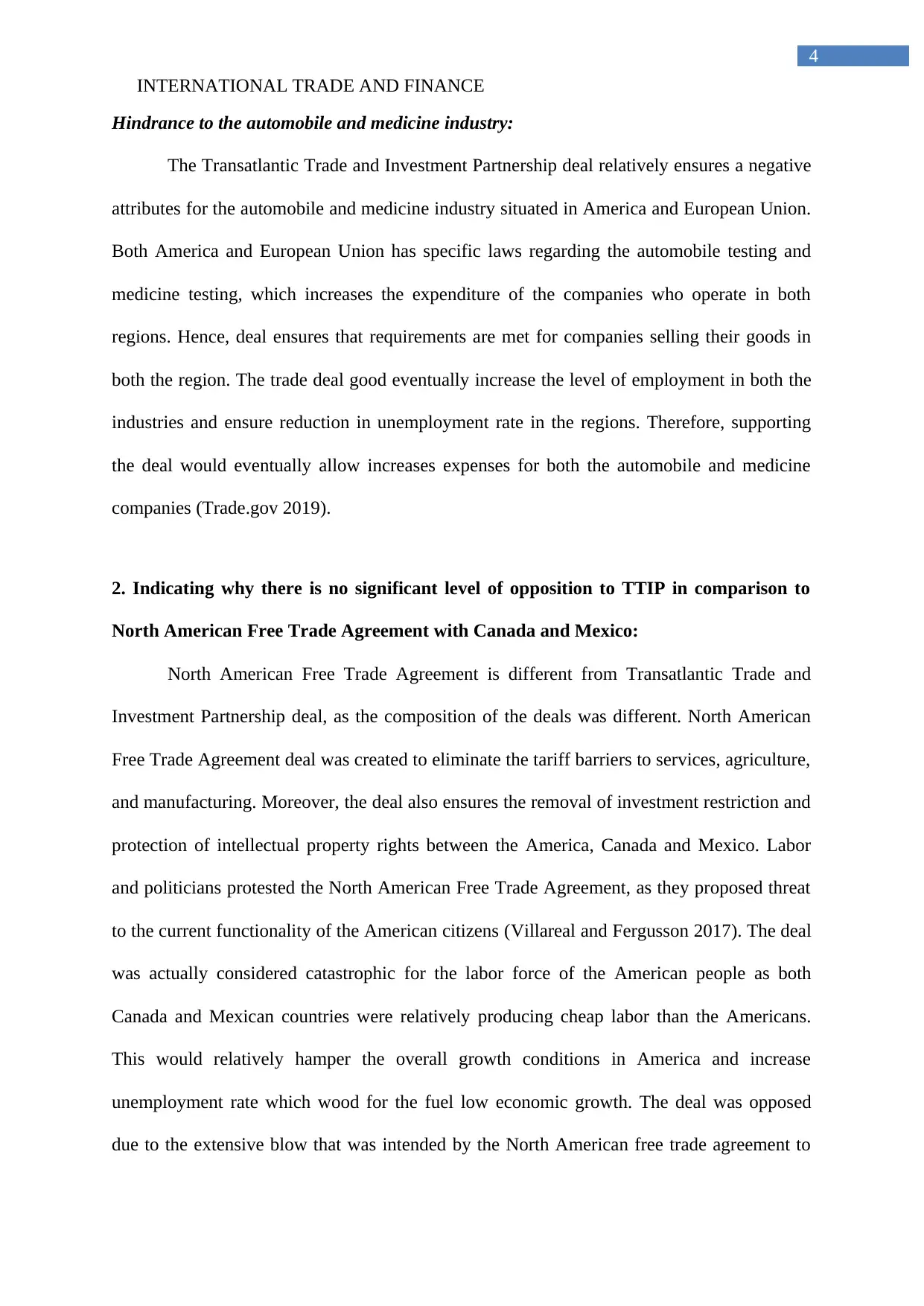
INTERNATIONAL TRADE AND FINANCE
4
Hindrance to the automobile and medicine industry:
The Transatlantic Trade and Investment Partnership deal relatively ensures a negative
attributes for the automobile and medicine industry situated in America and European Union.
Both America and European Union has specific laws regarding the automobile testing and
medicine testing, which increases the expenditure of the companies who operate in both
regions. Hence, deal ensures that requirements are met for companies selling their goods in
both the region. The trade deal good eventually increase the level of employment in both the
industries and ensure reduction in unemployment rate in the regions. Therefore, supporting
the deal would eventually allow increases expenses for both the automobile and medicine
companies (Trade.gov 2019).
2. Indicating why there is no significant level of opposition to TTIP in comparison to
North American Free Trade Agreement with Canada and Mexico:
North American Free Trade Agreement is different from Transatlantic Trade and
Investment Partnership deal, as the composition of the deals was different. North American
Free Trade Agreement deal was created to eliminate the tariff barriers to services, agriculture,
and manufacturing. Moreover, the deal also ensures the removal of investment restriction and
protection of intellectual property rights between the America, Canada and Mexico. Labor
and politicians protested the North American Free Trade Agreement, as they proposed threat
to the current functionality of the American citizens (Villareal and Fergusson 2017). The deal
was actually considered catastrophic for the labor force of the American people as both
Canada and Mexican countries were relatively producing cheap labor than the Americans.
This would relatively hamper the overall growth conditions in America and increase
unemployment rate which wood for the fuel low economic growth. The deal was opposed
due to the extensive blow that was intended by the North American free trade agreement to
4
Hindrance to the automobile and medicine industry:
The Transatlantic Trade and Investment Partnership deal relatively ensures a negative
attributes for the automobile and medicine industry situated in America and European Union.
Both America and European Union has specific laws regarding the automobile testing and
medicine testing, which increases the expenditure of the companies who operate in both
regions. Hence, deal ensures that requirements are met for companies selling their goods in
both the region. The trade deal good eventually increase the level of employment in both the
industries and ensure reduction in unemployment rate in the regions. Therefore, supporting
the deal would eventually allow increases expenses for both the automobile and medicine
companies (Trade.gov 2019).
2. Indicating why there is no significant level of opposition to TTIP in comparison to
North American Free Trade Agreement with Canada and Mexico:
North American Free Trade Agreement is different from Transatlantic Trade and
Investment Partnership deal, as the composition of the deals was different. North American
Free Trade Agreement deal was created to eliminate the tariff barriers to services, agriculture,
and manufacturing. Moreover, the deal also ensures the removal of investment restriction and
protection of intellectual property rights between the America, Canada and Mexico. Labor
and politicians protested the North American Free Trade Agreement, as they proposed threat
to the current functionality of the American citizens (Villareal and Fergusson 2017). The deal
was actually considered catastrophic for the labor force of the American people as both
Canada and Mexican countries were relatively producing cheap labor than the Americans.
This would relatively hamper the overall growth conditions in America and increase
unemployment rate which wood for the fuel low economic growth. The deal was opposed
due to the extensive blow that was intended by the North American free trade agreement to
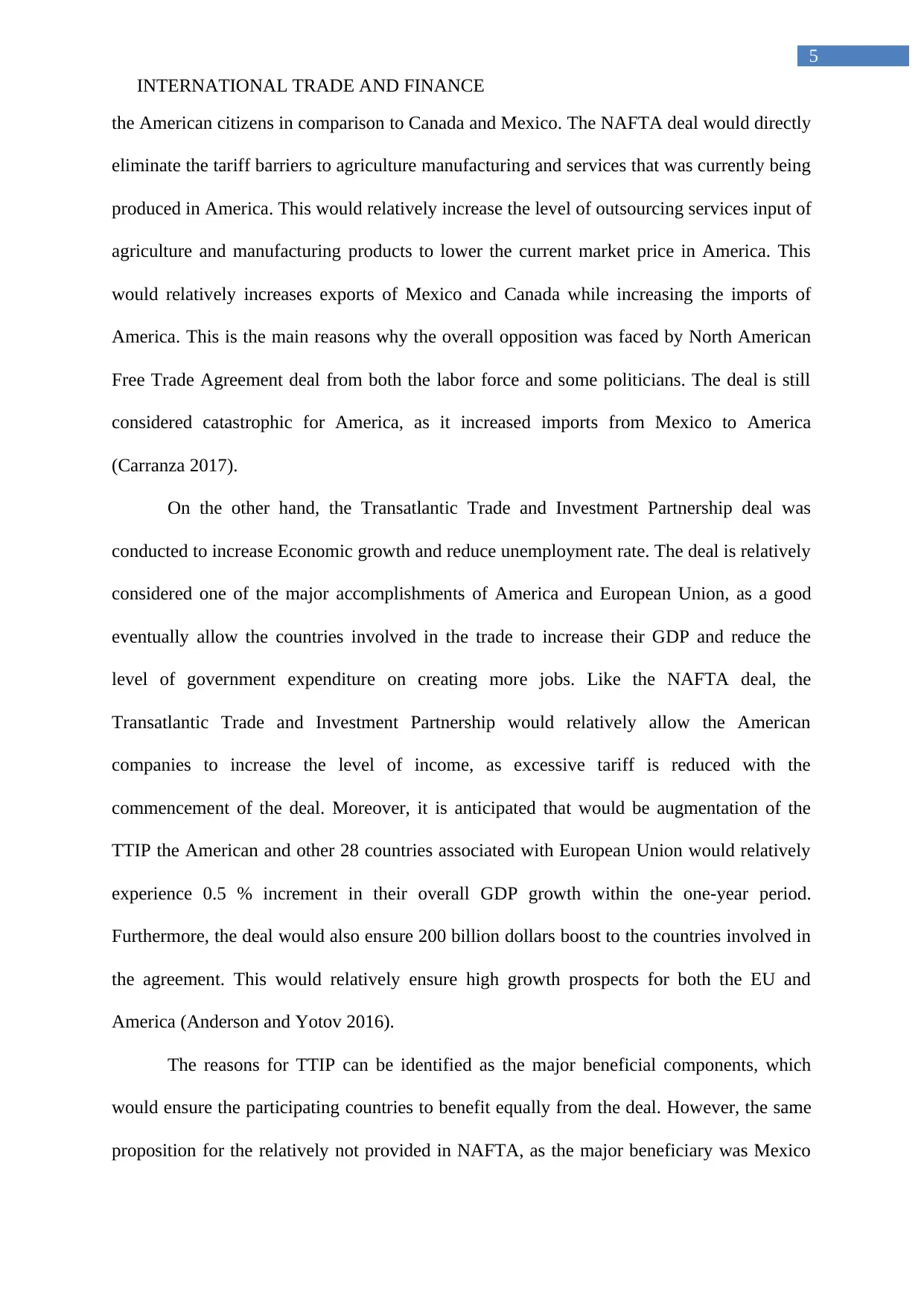
INTERNATIONAL TRADE AND FINANCE
5
the American citizens in comparison to Canada and Mexico. The NAFTA deal would directly
eliminate the tariff barriers to agriculture manufacturing and services that was currently being
produced in America. This would relatively increase the level of outsourcing services input of
agriculture and manufacturing products to lower the current market price in America. This
would relatively increases exports of Mexico and Canada while increasing the imports of
America. This is the main reasons why the overall opposition was faced by North American
Free Trade Agreement deal from both the labor force and some politicians. The deal is still
considered catastrophic for America, as it increased imports from Mexico to America
(Carranza 2017).
On the other hand, the Transatlantic Trade and Investment Partnership deal was
conducted to increase Economic growth and reduce unemployment rate. The deal is relatively
considered one of the major accomplishments of America and European Union, as a good
eventually allow the countries involved in the trade to increase their GDP and reduce the
level of government expenditure on creating more jobs. Like the NAFTA deal, the
Transatlantic Trade and Investment Partnership would relatively allow the American
companies to increase the level of income, as excessive tariff is reduced with the
commencement of the deal. Moreover, it is anticipated that would be augmentation of the
TTIP the American and other 28 countries associated with European Union would relatively
experience 0.5 % increment in their overall GDP growth within the one-year period.
Furthermore, the deal would also ensure 200 billion dollars boost to the countries involved in
the agreement. This would relatively ensure high growth prospects for both the EU and
America (Anderson and Yotov 2016).
The reasons for TTIP can be identified as the major beneficial components, which
would ensure the participating countries to benefit equally from the deal. However, the same
proposition for the relatively not provided in NAFTA, as the major beneficiary was Mexico
5
the American citizens in comparison to Canada and Mexico. The NAFTA deal would directly
eliminate the tariff barriers to agriculture manufacturing and services that was currently being
produced in America. This would relatively increase the level of outsourcing services input of
agriculture and manufacturing products to lower the current market price in America. This
would relatively increases exports of Mexico and Canada while increasing the imports of
America. This is the main reasons why the overall opposition was faced by North American
Free Trade Agreement deal from both the labor force and some politicians. The deal is still
considered catastrophic for America, as it increased imports from Mexico to America
(Carranza 2017).
On the other hand, the Transatlantic Trade and Investment Partnership deal was
conducted to increase Economic growth and reduce unemployment rate. The deal is relatively
considered one of the major accomplishments of America and European Union, as a good
eventually allow the countries involved in the trade to increase their GDP and reduce the
level of government expenditure on creating more jobs. Like the NAFTA deal, the
Transatlantic Trade and Investment Partnership would relatively allow the American
companies to increase the level of income, as excessive tariff is reduced with the
commencement of the deal. Moreover, it is anticipated that would be augmentation of the
TTIP the American and other 28 countries associated with European Union would relatively
experience 0.5 % increment in their overall GDP growth within the one-year period.
Furthermore, the deal would also ensure 200 billion dollars boost to the countries involved in
the agreement. This would relatively ensure high growth prospects for both the EU and
America (Anderson and Yotov 2016).
The reasons for TTIP can be identified as the major beneficial components, which
would ensure the participating countries to benefit equally from the deal. However, the same
proposition for the relatively not provided in NAFTA, as the major beneficiary was Mexico
⊘ This is a preview!⊘
Do you want full access?
Subscribe today to unlock all pages.

Trusted by 1+ million students worldwide
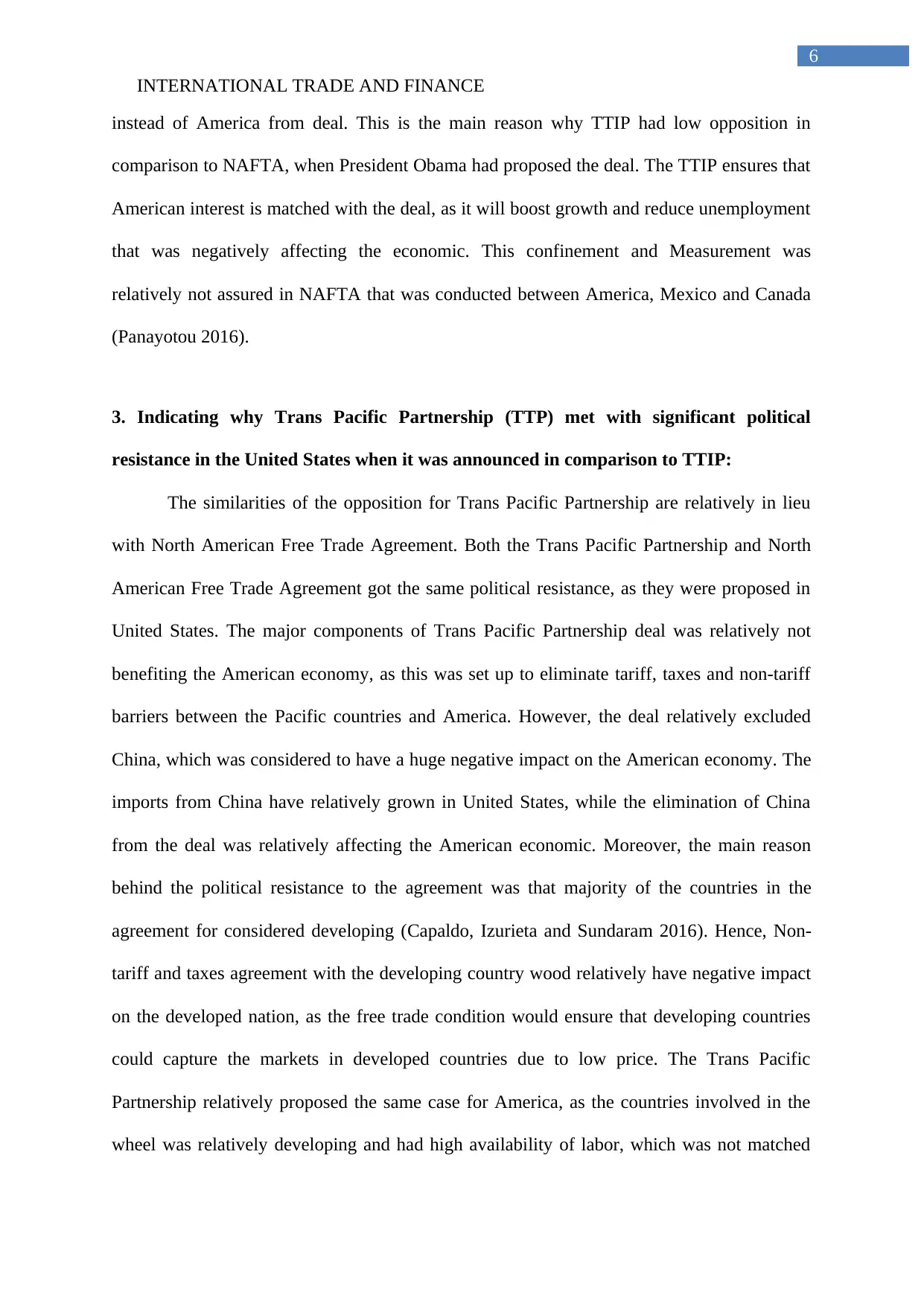
INTERNATIONAL TRADE AND FINANCE
6
instead of America from deal. This is the main reason why TTIP had low opposition in
comparison to NAFTA, when President Obama had proposed the deal. The TTIP ensures that
American interest is matched with the deal, as it will boost growth and reduce unemployment
that was negatively affecting the economic. This confinement and Measurement was
relatively not assured in NAFTA that was conducted between America, Mexico and Canada
(Panayotou 2016).
3. Indicating why Trans Pacific Partnership (TTP) met with significant political
resistance in the United States when it was announced in comparison to TTIP:
The similarities of the opposition for Trans Pacific Partnership are relatively in lieu
with North American Free Trade Agreement. Both the Trans Pacific Partnership and North
American Free Trade Agreement got the same political resistance, as they were proposed in
United States. The major components of Trans Pacific Partnership deal was relatively not
benefiting the American economy, as this was set up to eliminate tariff, taxes and non-tariff
barriers between the Pacific countries and America. However, the deal relatively excluded
China, which was considered to have a huge negative impact on the American economy. The
imports from China have relatively grown in United States, while the elimination of China
from the deal was relatively affecting the American economic. Moreover, the main reason
behind the political resistance to the agreement was that majority of the countries in the
agreement for considered developing (Capaldo, Izurieta and Sundaram 2016). Hence, Non-
tariff and taxes agreement with the developing country wood relatively have negative impact
on the developed nation, as the free trade condition would ensure that developing countries
could capture the markets in developed countries due to low price. The Trans Pacific
Partnership relatively proposed the same case for America, as the countries involved in the
wheel was relatively developing and had high availability of labor, which was not matched
6
instead of America from deal. This is the main reason why TTIP had low opposition in
comparison to NAFTA, when President Obama had proposed the deal. The TTIP ensures that
American interest is matched with the deal, as it will boost growth and reduce unemployment
that was negatively affecting the economic. This confinement and Measurement was
relatively not assured in NAFTA that was conducted between America, Mexico and Canada
(Panayotou 2016).
3. Indicating why Trans Pacific Partnership (TTP) met with significant political
resistance in the United States when it was announced in comparison to TTIP:
The similarities of the opposition for Trans Pacific Partnership are relatively in lieu
with North American Free Trade Agreement. Both the Trans Pacific Partnership and North
American Free Trade Agreement got the same political resistance, as they were proposed in
United States. The major components of Trans Pacific Partnership deal was relatively not
benefiting the American economy, as this was set up to eliminate tariff, taxes and non-tariff
barriers between the Pacific countries and America. However, the deal relatively excluded
China, which was considered to have a huge negative impact on the American economy. The
imports from China have relatively grown in United States, while the elimination of China
from the deal was relatively affecting the American economic. Moreover, the main reason
behind the political resistance to the agreement was that majority of the countries in the
agreement for considered developing (Capaldo, Izurieta and Sundaram 2016). Hence, Non-
tariff and taxes agreement with the developing country wood relatively have negative impact
on the developed nation, as the free trade condition would ensure that developing countries
could capture the markets in developed countries due to low price. The Trans Pacific
Partnership relatively proposed the same case for America, as the countries involved in the
wheel was relatively developing and had high availability of labor, which was not matched
Paraphrase This Document
Need a fresh take? Get an instant paraphrase of this document with our AI Paraphraser
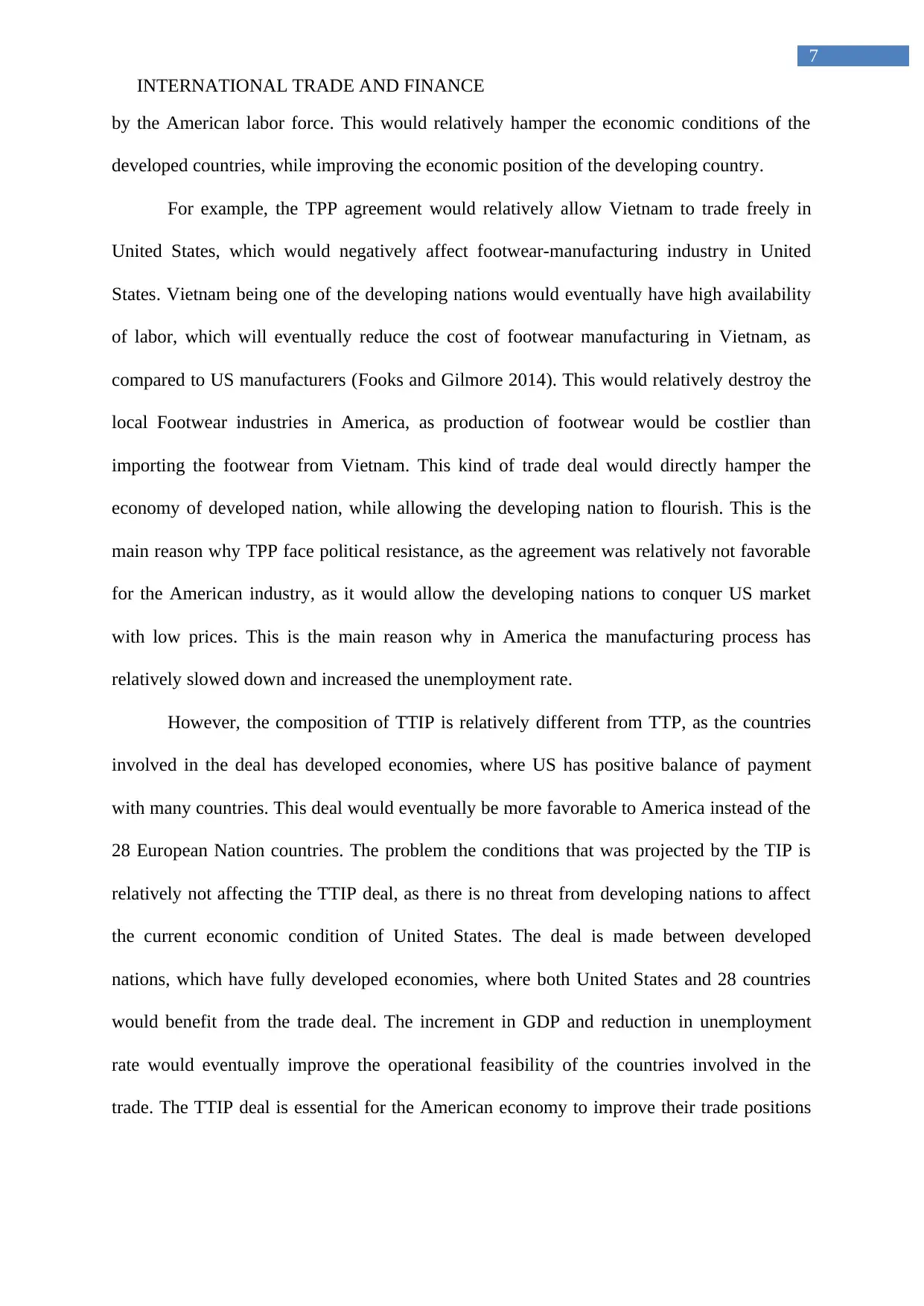
INTERNATIONAL TRADE AND FINANCE
7
by the American labor force. This would relatively hamper the economic conditions of the
developed countries, while improving the economic position of the developing country.
For example, the TPP agreement would relatively allow Vietnam to trade freely in
United States, which would negatively affect footwear-manufacturing industry in United
States. Vietnam being one of the developing nations would eventually have high availability
of labor, which will eventually reduce the cost of footwear manufacturing in Vietnam, as
compared to US manufacturers (Fooks and Gilmore 2014). This would relatively destroy the
local Footwear industries in America, as production of footwear would be costlier than
importing the footwear from Vietnam. This kind of trade deal would directly hamper the
economy of developed nation, while allowing the developing nation to flourish. This is the
main reason why TPP face political resistance, as the agreement was relatively not favorable
for the American industry, as it would allow the developing nations to conquer US market
with low prices. This is the main reason why in America the manufacturing process has
relatively slowed down and increased the unemployment rate.
However, the composition of TTIP is relatively different from TTP, as the countries
involved in the deal has developed economies, where US has positive balance of payment
with many countries. This deal would eventually be more favorable to America instead of the
28 European Nation countries. The problem the conditions that was projected by the TIP is
relatively not affecting the TTIP deal, as there is no threat from developing nations to affect
the current economic condition of United States. The deal is made between developed
nations, which have fully developed economies, where both United States and 28 countries
would benefit from the trade deal. The increment in GDP and reduction in unemployment
rate would eventually improve the operational feasibility of the countries involved in the
trade. The TTIP deal is essential for the American economy to improve their trade positions
7
by the American labor force. This would relatively hamper the economic conditions of the
developed countries, while improving the economic position of the developing country.
For example, the TPP agreement would relatively allow Vietnam to trade freely in
United States, which would negatively affect footwear-manufacturing industry in United
States. Vietnam being one of the developing nations would eventually have high availability
of labor, which will eventually reduce the cost of footwear manufacturing in Vietnam, as
compared to US manufacturers (Fooks and Gilmore 2014). This would relatively destroy the
local Footwear industries in America, as production of footwear would be costlier than
importing the footwear from Vietnam. This kind of trade deal would directly hamper the
economy of developed nation, while allowing the developing nation to flourish. This is the
main reason why TPP face political resistance, as the agreement was relatively not favorable
for the American industry, as it would allow the developing nations to conquer US market
with low prices. This is the main reason why in America the manufacturing process has
relatively slowed down and increased the unemployment rate.
However, the composition of TTIP is relatively different from TTP, as the countries
involved in the deal has developed economies, where US has positive balance of payment
with many countries. This deal would eventually be more favorable to America instead of the
28 European Nation countries. The problem the conditions that was projected by the TIP is
relatively not affecting the TTIP deal, as there is no threat from developing nations to affect
the current economic condition of United States. The deal is made between developed
nations, which have fully developed economies, where both United States and 28 countries
would benefit from the trade deal. The increment in GDP and reduction in unemployment
rate would eventually improve the operational feasibility of the countries involved in the
trade. The TTIP deal is essential for the American economy to improve their trade positions
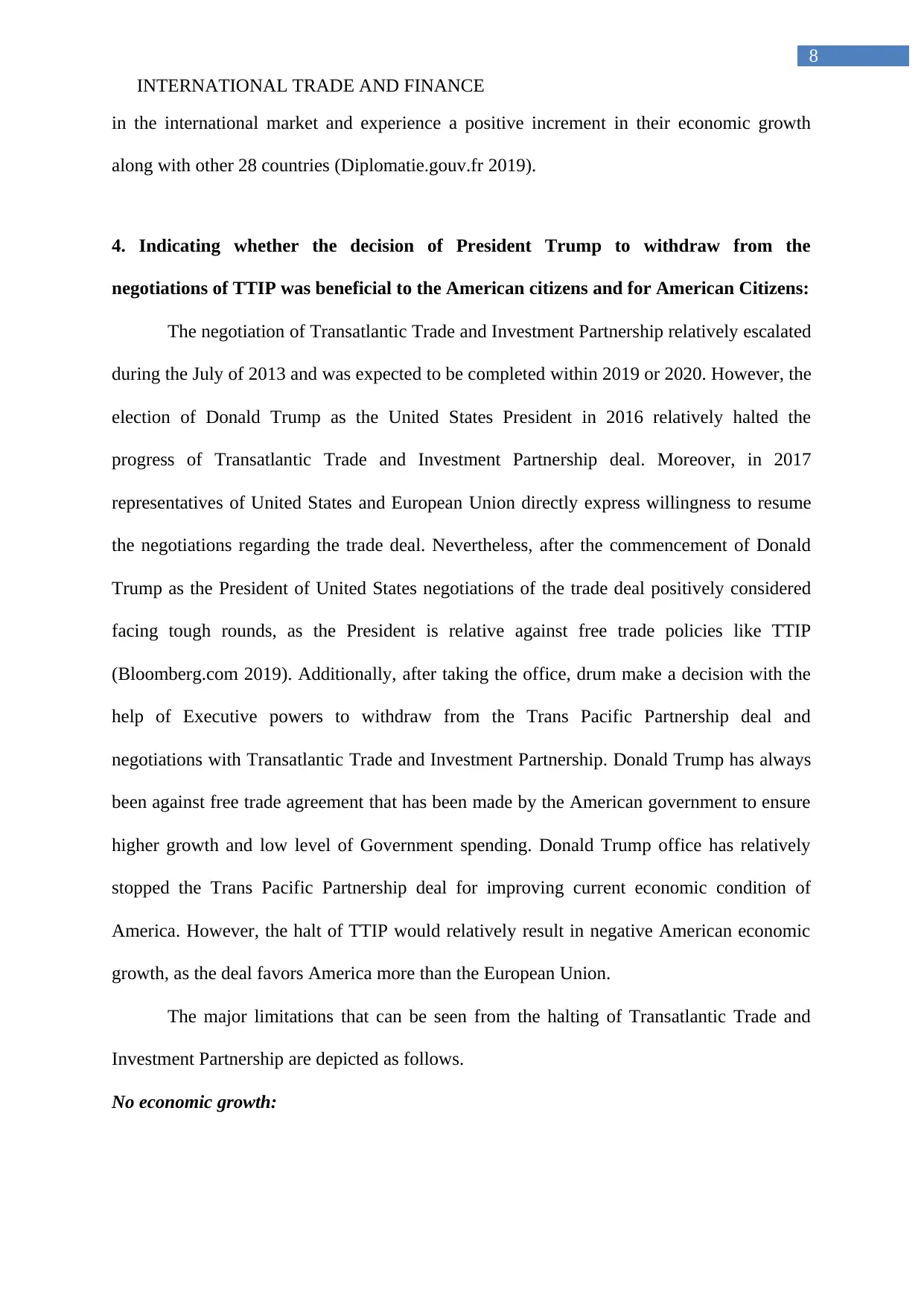
INTERNATIONAL TRADE AND FINANCE
8
in the international market and experience a positive increment in their economic growth
along with other 28 countries (Diplomatie.gouv.fr 2019).
4. Indicating whether the decision of President Trump to withdraw from the
negotiations of TTIP was beneficial to the American citizens and for American Citizens:
The negotiation of Transatlantic Trade and Investment Partnership relatively escalated
during the July of 2013 and was expected to be completed within 2019 or 2020. However, the
election of Donald Trump as the United States President in 2016 relatively halted the
progress of Transatlantic Trade and Investment Partnership deal. Moreover, in 2017
representatives of United States and European Union directly express willingness to resume
the negotiations regarding the trade deal. Nevertheless, after the commencement of Donald
Trump as the President of United States negotiations of the trade deal positively considered
facing tough rounds, as the President is relative against free trade policies like TTIP
(Bloomberg.com 2019). Additionally, after taking the office, drum make a decision with the
help of Executive powers to withdraw from the Trans Pacific Partnership deal and
negotiations with Transatlantic Trade and Investment Partnership. Donald Trump has always
been against free trade agreement that has been made by the American government to ensure
higher growth and low level of Government spending. Donald Trump office has relatively
stopped the Trans Pacific Partnership deal for improving current economic condition of
America. However, the halt of TTIP would relatively result in negative American economic
growth, as the deal favors America more than the European Union.
The major limitations that can be seen from the halting of Transatlantic Trade and
Investment Partnership are depicted as follows.
No economic growth:
8
in the international market and experience a positive increment in their economic growth
along with other 28 countries (Diplomatie.gouv.fr 2019).
4. Indicating whether the decision of President Trump to withdraw from the
negotiations of TTIP was beneficial to the American citizens and for American Citizens:
The negotiation of Transatlantic Trade and Investment Partnership relatively escalated
during the July of 2013 and was expected to be completed within 2019 or 2020. However, the
election of Donald Trump as the United States President in 2016 relatively halted the
progress of Transatlantic Trade and Investment Partnership deal. Moreover, in 2017
representatives of United States and European Union directly express willingness to resume
the negotiations regarding the trade deal. Nevertheless, after the commencement of Donald
Trump as the President of United States negotiations of the trade deal positively considered
facing tough rounds, as the President is relative against free trade policies like TTIP
(Bloomberg.com 2019). Additionally, after taking the office, drum make a decision with the
help of Executive powers to withdraw from the Trans Pacific Partnership deal and
negotiations with Transatlantic Trade and Investment Partnership. Donald Trump has always
been against free trade agreement that has been made by the American government to ensure
higher growth and low level of Government spending. Donald Trump office has relatively
stopped the Trans Pacific Partnership deal for improving current economic condition of
America. However, the halt of TTIP would relatively result in negative American economic
growth, as the deal favors America more than the European Union.
The major limitations that can be seen from the halting of Transatlantic Trade and
Investment Partnership are depicted as follows.
No economic growth:
⊘ This is a preview!⊘
Do you want full access?
Subscribe today to unlock all pages.

Trusted by 1+ million students worldwide
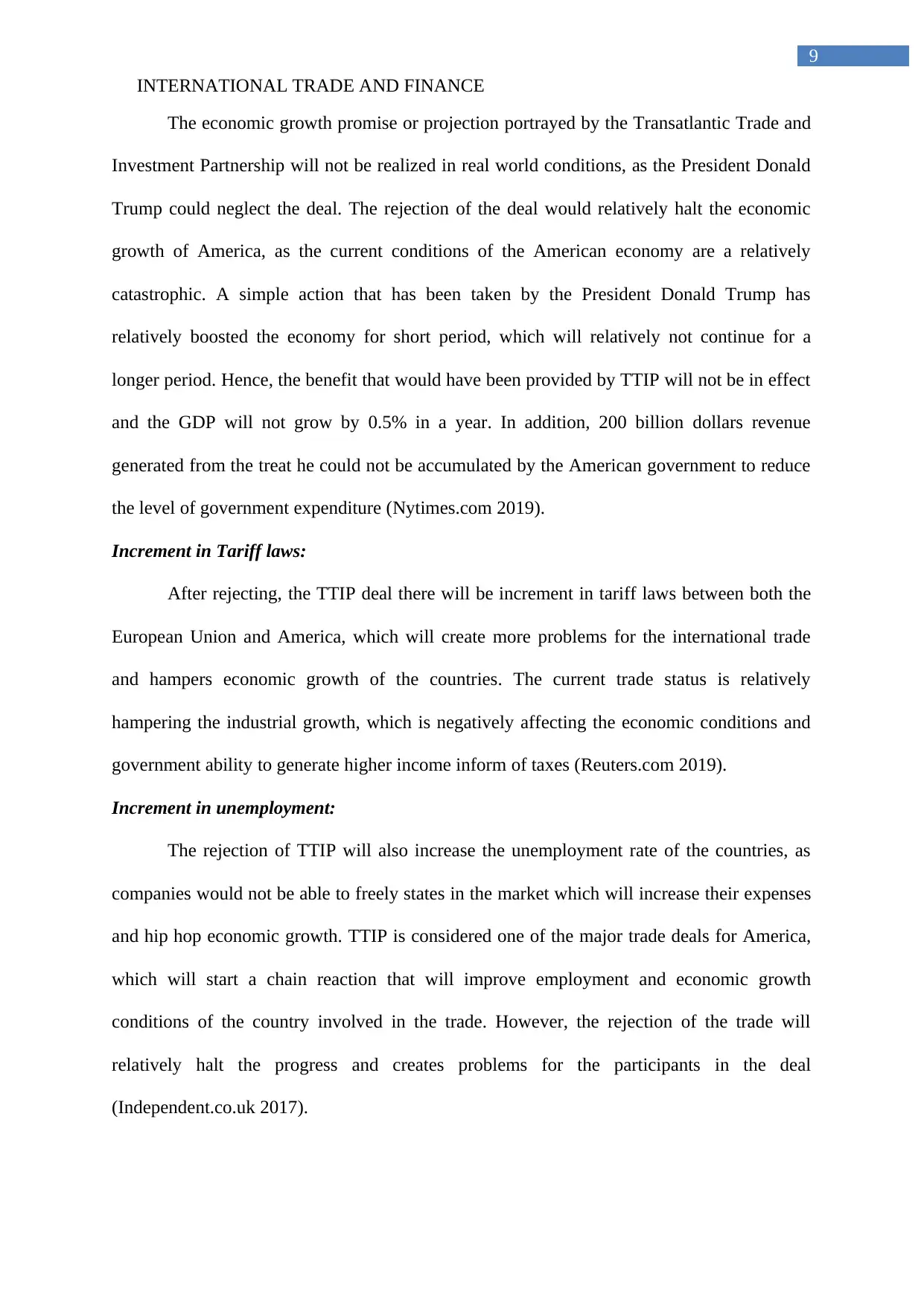
INTERNATIONAL TRADE AND FINANCE
9
The economic growth promise or projection portrayed by the Transatlantic Trade and
Investment Partnership will not be realized in real world conditions, as the President Donald
Trump could neglect the deal. The rejection of the deal would relatively halt the economic
growth of America, as the current conditions of the American economy are a relatively
catastrophic. A simple action that has been taken by the President Donald Trump has
relatively boosted the economy for short period, which will relatively not continue for a
longer period. Hence, the benefit that would have been provided by TTIP will not be in effect
and the GDP will not grow by 0.5% in a year. In addition, 200 billion dollars revenue
generated from the treat he could not be accumulated by the American government to reduce
the level of government expenditure (Nytimes.com 2019).
Increment in Tariff laws:
After rejecting, the TTIP deal there will be increment in tariff laws between both the
European Union and America, which will create more problems for the international trade
and hampers economic growth of the countries. The current trade status is relatively
hampering the industrial growth, which is negatively affecting the economic conditions and
government ability to generate higher income inform of taxes (Reuters.com 2019).
Increment in unemployment:
The rejection of TTIP will also increase the unemployment rate of the countries, as
companies would not be able to freely states in the market which will increase their expenses
and hip hop economic growth. TTIP is considered one of the major trade deals for America,
which will start a chain reaction that will improve employment and economic growth
conditions of the country involved in the trade. However, the rejection of the trade will
relatively halt the progress and creates problems for the participants in the deal
(Independent.co.uk 2017).
9
The economic growth promise or projection portrayed by the Transatlantic Trade and
Investment Partnership will not be realized in real world conditions, as the President Donald
Trump could neglect the deal. The rejection of the deal would relatively halt the economic
growth of America, as the current conditions of the American economy are a relatively
catastrophic. A simple action that has been taken by the President Donald Trump has
relatively boosted the economy for short period, which will relatively not continue for a
longer period. Hence, the benefit that would have been provided by TTIP will not be in effect
and the GDP will not grow by 0.5% in a year. In addition, 200 billion dollars revenue
generated from the treat he could not be accumulated by the American government to reduce
the level of government expenditure (Nytimes.com 2019).
Increment in Tariff laws:
After rejecting, the TTIP deal there will be increment in tariff laws between both the
European Union and America, which will create more problems for the international trade
and hampers economic growth of the countries. The current trade status is relatively
hampering the industrial growth, which is negatively affecting the economic conditions and
government ability to generate higher income inform of taxes (Reuters.com 2019).
Increment in unemployment:
The rejection of TTIP will also increase the unemployment rate of the countries, as
companies would not be able to freely states in the market which will increase their expenses
and hip hop economic growth. TTIP is considered one of the major trade deals for America,
which will start a chain reaction that will improve employment and economic growth
conditions of the country involved in the trade. However, the rejection of the trade will
relatively halt the progress and creates problems for the participants in the deal
(Independent.co.uk 2017).
Paraphrase This Document
Need a fresh take? Get an instant paraphrase of this document with our AI Paraphraser
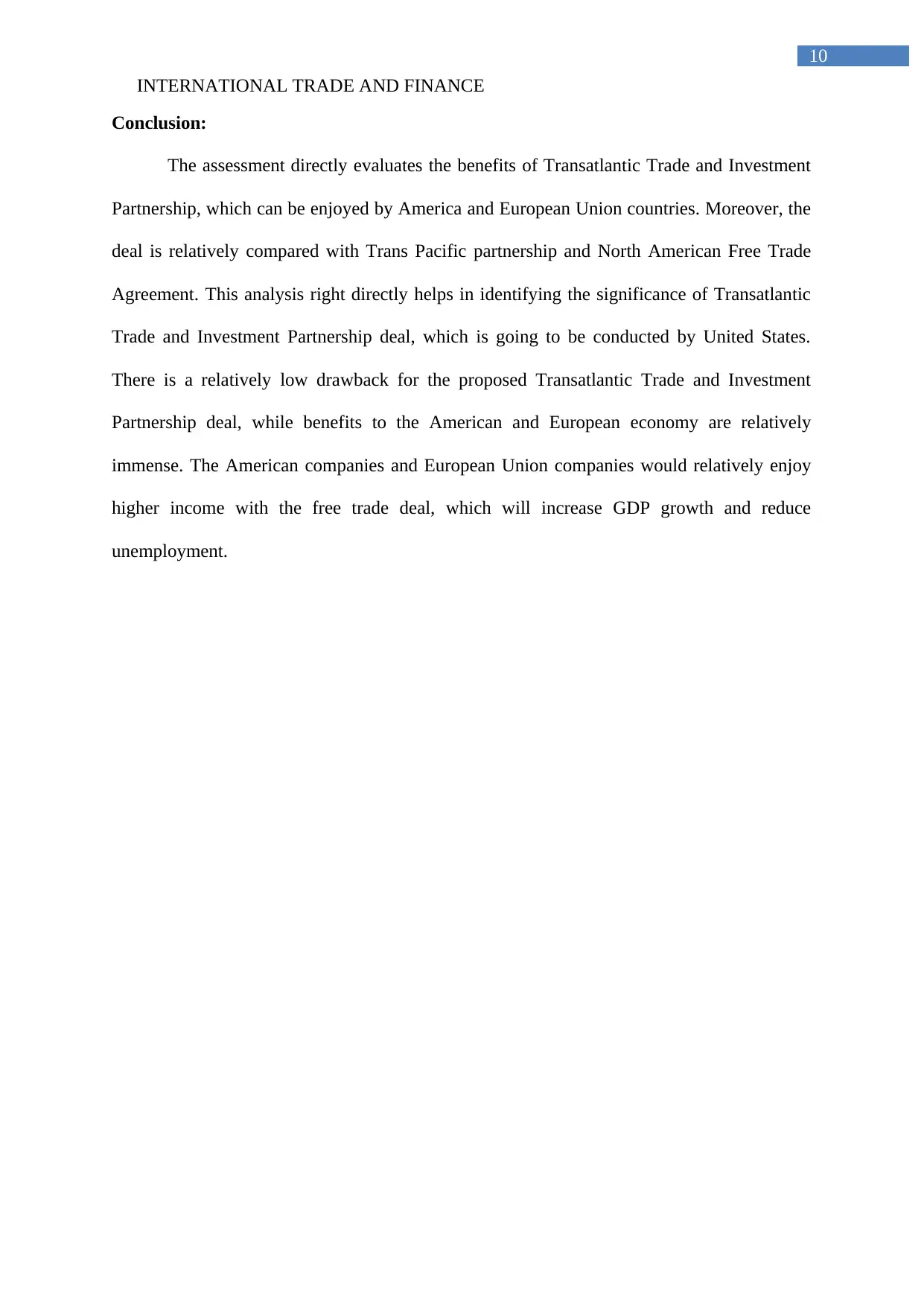
INTERNATIONAL TRADE AND FINANCE
10
Conclusion:
The assessment directly evaluates the benefits of Transatlantic Trade and Investment
Partnership, which can be enjoyed by America and European Union countries. Moreover, the
deal is relatively compared with Trans Pacific partnership and North American Free Trade
Agreement. This analysis right directly helps in identifying the significance of Transatlantic
Trade and Investment Partnership deal, which is going to be conducted by United States.
There is a relatively low drawback for the proposed Transatlantic Trade and Investment
Partnership deal, while benefits to the American and European economy are relatively
immense. The American companies and European Union companies would relatively enjoy
higher income with the free trade deal, which will increase GDP growth and reduce
unemployment.
10
Conclusion:
The assessment directly evaluates the benefits of Transatlantic Trade and Investment
Partnership, which can be enjoyed by America and European Union countries. Moreover, the
deal is relatively compared with Trans Pacific partnership and North American Free Trade
Agreement. This analysis right directly helps in identifying the significance of Transatlantic
Trade and Investment Partnership deal, which is going to be conducted by United States.
There is a relatively low drawback for the proposed Transatlantic Trade and Investment
Partnership deal, while benefits to the American and European economy are relatively
immense. The American companies and European Union companies would relatively enjoy
higher income with the free trade deal, which will increase GDP growth and reduce
unemployment.
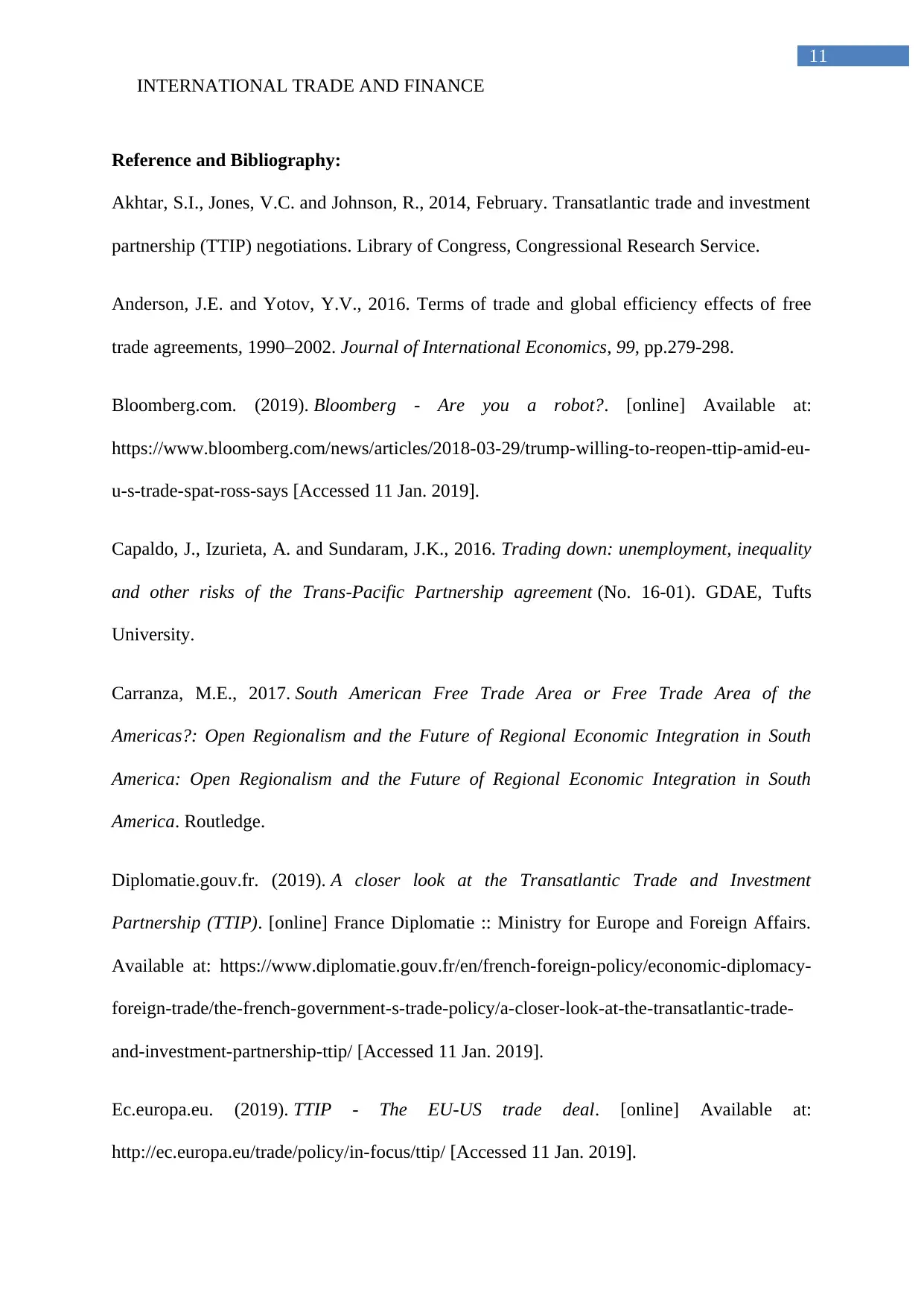
INTERNATIONAL TRADE AND FINANCE
11
Reference and Bibliography:
Akhtar, S.I., Jones, V.C. and Johnson, R., 2014, February. Transatlantic trade and investment
partnership (TTIP) negotiations. Library of Congress, Congressional Research Service.
Anderson, J.E. and Yotov, Y.V., 2016. Terms of trade and global efficiency effects of free
trade agreements, 1990–2002. Journal of International Economics, 99, pp.279-298.
Bloomberg.com. (2019). Bloomberg - Are you a robot?. [online] Available at:
https://www.bloomberg.com/news/articles/2018-03-29/trump-willing-to-reopen-ttip-amid-eu-
u-s-trade-spat-ross-says [Accessed 11 Jan. 2019].
Capaldo, J., Izurieta, A. and Sundaram, J.K., 2016. Trading down: unemployment, inequality
and other risks of the Trans-Pacific Partnership agreement (No. 16-01). GDAE, Tufts
University.
Carranza, M.E., 2017. South American Free Trade Area or Free Trade Area of the
Americas?: Open Regionalism and the Future of Regional Economic Integration in South
America: Open Regionalism and the Future of Regional Economic Integration in South
America. Routledge.
Diplomatie.gouv.fr. (2019). A closer look at the Transatlantic Trade and Investment
Partnership (TTIP). [online] France Diplomatie :: Ministry for Europe and Foreign Affairs.
Available at: https://www.diplomatie.gouv.fr/en/french-foreign-policy/economic-diplomacy-
foreign-trade/the-french-government-s-trade-policy/a-closer-look-at-the-transatlantic-trade-
and-investment-partnership-ttip/ [Accessed 11 Jan. 2019].
Ec.europa.eu. (2019). TTIP - The EU-US trade deal. [online] Available at:
http://ec.europa.eu/trade/policy/in-focus/ttip/ [Accessed 11 Jan. 2019].
11
Reference and Bibliography:
Akhtar, S.I., Jones, V.C. and Johnson, R., 2014, February. Transatlantic trade and investment
partnership (TTIP) negotiations. Library of Congress, Congressional Research Service.
Anderson, J.E. and Yotov, Y.V., 2016. Terms of trade and global efficiency effects of free
trade agreements, 1990–2002. Journal of International Economics, 99, pp.279-298.
Bloomberg.com. (2019). Bloomberg - Are you a robot?. [online] Available at:
https://www.bloomberg.com/news/articles/2018-03-29/trump-willing-to-reopen-ttip-amid-eu-
u-s-trade-spat-ross-says [Accessed 11 Jan. 2019].
Capaldo, J., Izurieta, A. and Sundaram, J.K., 2016. Trading down: unemployment, inequality
and other risks of the Trans-Pacific Partnership agreement (No. 16-01). GDAE, Tufts
University.
Carranza, M.E., 2017. South American Free Trade Area or Free Trade Area of the
Americas?: Open Regionalism and the Future of Regional Economic Integration in South
America: Open Regionalism and the Future of Regional Economic Integration in South
America. Routledge.
Diplomatie.gouv.fr. (2019). A closer look at the Transatlantic Trade and Investment
Partnership (TTIP). [online] France Diplomatie :: Ministry for Europe and Foreign Affairs.
Available at: https://www.diplomatie.gouv.fr/en/french-foreign-policy/economic-diplomacy-
foreign-trade/the-french-government-s-trade-policy/a-closer-look-at-the-transatlantic-trade-
and-investment-partnership-ttip/ [Accessed 11 Jan. 2019].
Ec.europa.eu. (2019). TTIP - The EU-US trade deal. [online] Available at:
http://ec.europa.eu/trade/policy/in-focus/ttip/ [Accessed 11 Jan. 2019].
⊘ This is a preview!⊘
Do you want full access?
Subscribe today to unlock all pages.

Trusted by 1+ million students worldwide
1 out of 14
Related Documents
Your All-in-One AI-Powered Toolkit for Academic Success.
+13062052269
info@desklib.com
Available 24*7 on WhatsApp / Email
![[object Object]](/_next/static/media/star-bottom.7253800d.svg)
Unlock your academic potential
Copyright © 2020–2025 A2Z Services. All Rights Reserved. Developed and managed by ZUCOL.




